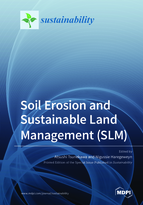Soil Erosion and Sustainable Land Management (SLM)
A special issue of Sustainability (ISSN 2071-1050).
Deadline for manuscript submissions: closed (31 December 2020) | Viewed by 50016
Special Issue Editors
Interests: sustainable land management; environmental planning; conservation informatics; desertification; land degradation and restoration
Special Issue Information
Dear Colleagues,
Soil erosion-induced land degradation is one of the top soil threats identified in the 2015 Status of the World’s Soil Resources report. Many studies have found that the risk of degradation will get worse because of the unsustainable use of the limited land and water resources under scenarios of climate and land-use changes, and population growth. On the other hand, the proper identification and implementation of sustainable land management (SLM) practices are believed to offer a triple-win solution of conserving the resources, increasing agricultural productivity, and improving human livelihood and well-being.
However, success in fighting land degradation through SLM requires an improved understanding and documentation of land degradation processes and their risks, as well as the development and adoption of mitigation techniques and approaches. Published figures on global soil erosion show huge variations (20–200 Gton), suggesting that the available estimates remain very uncertain. Moreover, despite the fact that over 825 SLM practices and 360 approaches are documented worldwide, there is a great need to clarify their impacts in different contexts, and to adopt and optimize them under different conditions. There is still a need to develop more refined soil erosion assessment techniques and new SLM technologies and approaches using world-wide increased data availability resulting from field observation, monitoring, remote sensing, and/or modelling.
This Special Issue on the topic of “Soil Erosion and SLM” invites new works that address understanding the rates, causes, and consequences of soil erosion, mainly by water and wind, as well as the development and evaluation of SLM technologies from different perspectives of SLM, through an improvement in ecosystem regulating services (e.g., climate, soil, water, nutrient, organic matter, and biomass), land productivity (e.g., food and fodder), and livelihood and human well-being (e.g., economic returns, poverty reduction, and health improvement), targeting geographic regions where the risk of erosion-caused land degradation and the potential for its alleviation through SLM are plausible under present and future scenarios.
Prof. Atsushi Tsunekawa
Dr. Nigussie Haregeweyn
Guest Editors
Manuscript Submission Information
Manuscripts should be submitted online at www.mdpi.com by registering and logging in to this website. Once you are registered, click here to go to the submission form. Manuscripts can be submitted until the deadline. All submissions that pass pre-check are peer-reviewed. Accepted papers will be published continuously in the journal (as soon as accepted) and will be listed together on the special issue website. Research articles, review articles as well as short communications are invited. For planned papers, a title and short abstract (about 100 words) can be sent to the Editorial Office for announcement on this website.
Submitted manuscripts should not have been published previously, nor be under consideration for publication elsewhere (except conference proceedings papers). All manuscripts are thoroughly refereed through a single-blind peer-review process. A guide for authors and other relevant information for submission of manuscripts is available on the Instructions for Authors page. Sustainability is an international peer-reviewed open access semimonthly journal published by MDPI.
Please visit the Instructions for Authors page before submitting a manuscript. The Article Processing Charge (APC) for publication in this open access journal is 2400 CHF (Swiss Francs). Submitted papers should be well formatted and use good English. Authors may use MDPI's English editing service prior to publication or during author revisions.
Keywords
- land degradation
- soil erosion
- land use change
- organic matter
- sustainable land management
- land productivity
- ecosystem services
- livelihood and human well-being






